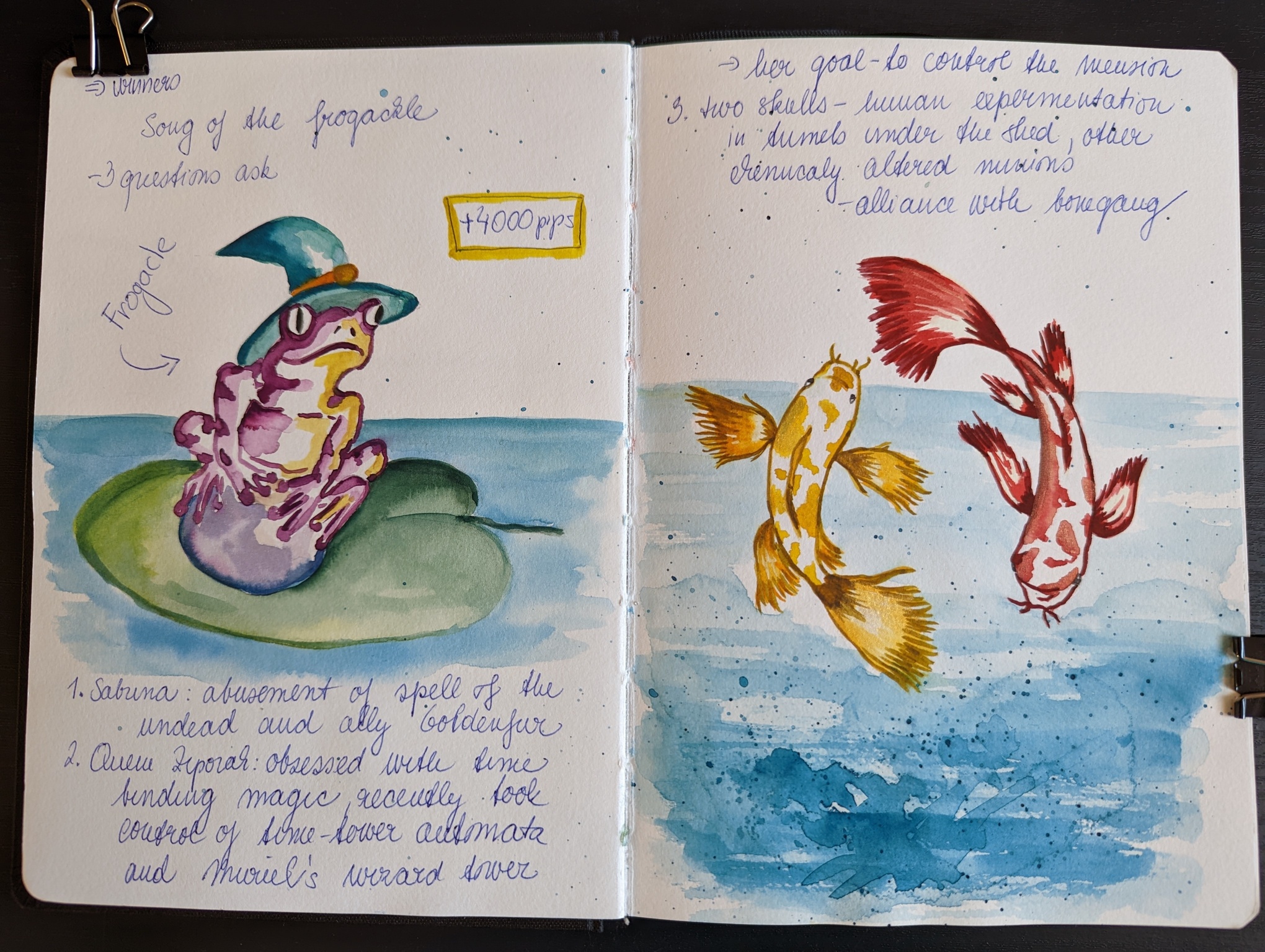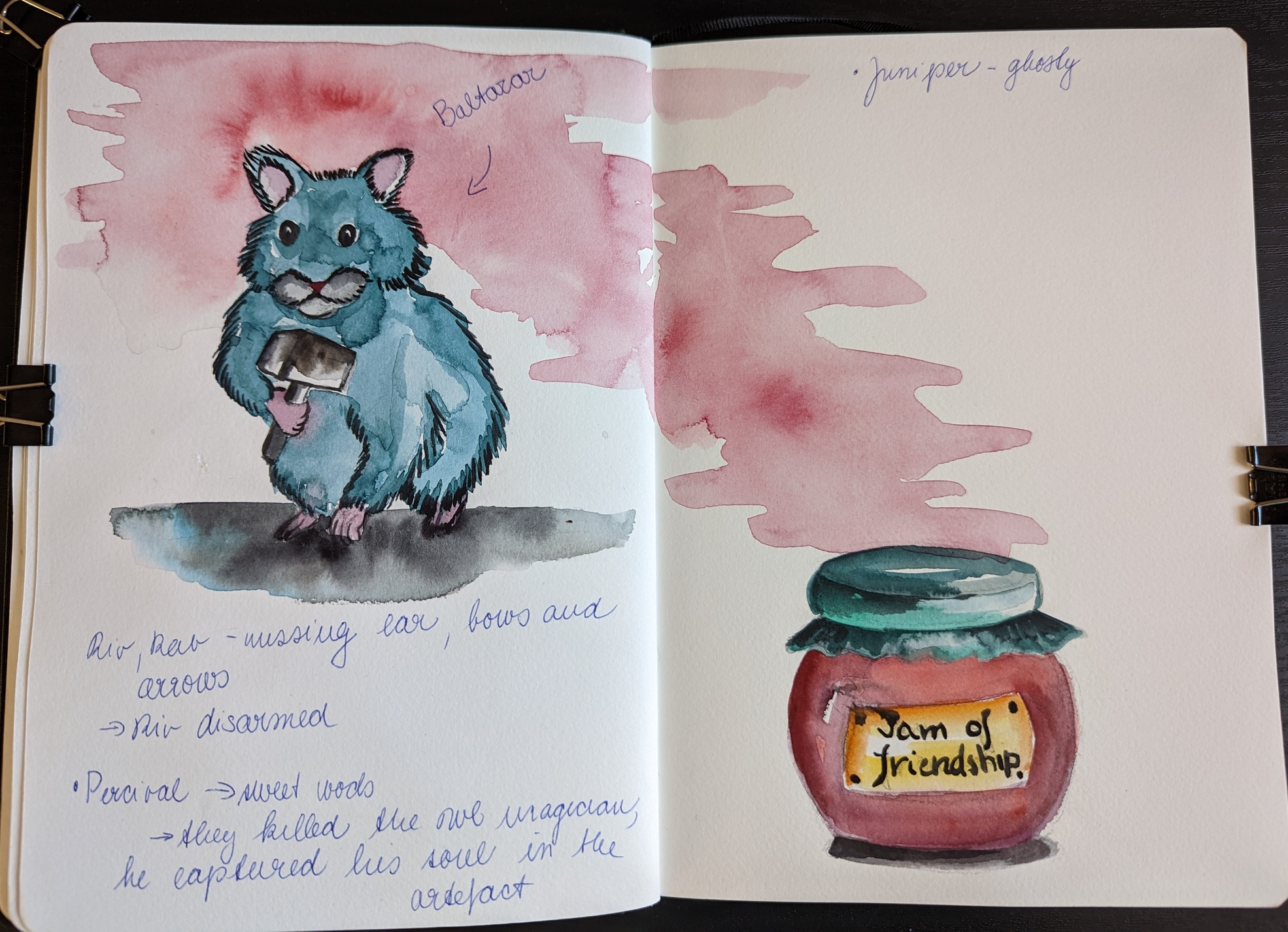Mausritter is an amazing sword & whiskers tabletop role-playing game. I wrote a bit about how I got to running it recently.
In my group, there are two players only. They are not influenced by previous pen-and-paper experience and they are not playing video games so they haven’t created the habit of using in-game violence to resolve situations. One of the players is even very anti-violence because the setting full of little sentient animals makes her feel for them. It was clearly said that the death of a character or even dear NPCs is something that we should avoid. The other player would be willing to use violence more often, yet still less often than an average player.

Mausritter is based on Into The Odd and the system itself leads to quick combats with real consequences. The book warns players that combat will be difficult and consequential (“Combat is dangerous business for mice, even brave adventurers. But sometimes it cannot be avoided.”) and that dying is part of the game (“Fight dirty. Run. Die. Roll a new mouse.”). The attacks in Mausritter always hit (there’s only the damage roll). So how can we run a low-lethality game in Mausritter? Is it even possible?
What Mausritter gives us mechanically
HP - hit protection in Mausritter (and Into The Odd family of games in general) is a quick refreshing resource representing the ability of a character to avoid real harm. We can imagine it being something like stamina that allows a character to dodge attacks etc. It can be (partly) refreshed after each combat during a short rest. When hit protection is depleted the character is being injured for real and their STR stat is being lowered according to the damage left. After each hit to the stat, the character has to roll an STR save and if they fail they are removed from combat but alive (“take injured condition and are incapacitated until tended to by an ally and take a short rest”. Rules as written, the character dies when their STR gets to 0 or lower.
That means that losing hit protection doesn’t mean harm is being done. It is easy-to-miss detail because our brains tend to treat this meta currency in the same way as hit points in other games. It’s also a bit contradictory to the claim that in Mausritter “attack always hits”. That claim is mainly trying to teach a player that they roll only once for their attack and the dice are based on their weapon. The way how I like to frame it is that the roll together with hit protection value answers both “will I hit?” and “how much I harm them?” questions.
This gives us several important things already:
- Losing a lot of HP is a very good signal to the player that the combat is getting dangerous.
- Every real harm can already remove a character from combat without dying.
- “If an incapacitated creature is left untended for 6 exploration Turns, they die.” So there’s an hour to save an incapacitated friend (or enemy!).
This gives GM a lot of tools to keep the lethality low. Player characters and NPC are actually quite likely to survive the combat and can be saved by friends or captured by enemies. Even if an incapacitated player character is abandoned by fleeing player characters it’s usually possible to find a reason why the enemies would keep them alive: to have leverage, to interrogate, to exchange for ransom, and many others. Even the antagonists that just want to eat them could store them for later (quite a common trope in stories we watch and read, all those bodies in cocoons).

House rules
The one house rule I would suggest, is to basically ignore the part when they die if the STR reaches 0. Take it as a signal to make the consequences hard but let the character live.
Some ideas follow. We should always make sure that those alternatives are fine at our table. I would also suggest negotiating this with the player and giving them options.
- There can be some permanent scarring or body damage. Losing a limb or an eye can be already very hard consequence for the character marking them for the rest of their life and it can already have a very strong emotional impact on their player.
- They can be removed from the play for a long time. For example, because of serious injury that will require a long recovery, or they could end up in a coma. If magic is involved there are practically no boundaries. Maybe their soul is captured in an artefact and their body will sleep until the characters figure out how to break the artefact. The player would have to create a new character (as if their character died) and it can be already emotional for them. But it gives room for the character to come back later (maybe there’s a magical cure or somebody who can be convinced to remove the curse from them etc.) The players can have a quest and work on getting the character back and later the player can choose which character they want to play.
- An alternative to this is some kind of emotional damage. Maybe the character is going to be so traumatised they’ll never go on an adventure again. The player would be invited to imagine the character “living in peace for the rest of their days”. It can be an interesting way how to keep the character as NPC in safety while getting them out of play.
What about NPCs and their death?
The same rules as to PCs apply. So there’s is plenty of room for saving and capturing them when the fight ends. Together with the house rule above it’s easy to remove death from the picture in most cases.
Another important piece of rules is morale. Rules, as written, say that:
“Whenever an antagonist is in a battle with the mice and reaches one of the following conditions, it must make a WIL save. On failure, the creature must flee or surrender. 1) Is obviously outmatched at the start of a battle, 2) Takes critical damage for the first time, 3) Sees an ally flee or fall

This rule has a significant impact on the game. Combat can quickly end because enemies just run away after the first one fell. It can snowball pretty quickly, sometimes maybe too quickly.
For example, the first enemy takes critical damage and manages to stay in combat but fails morale save and flees. Others roll because they see him running away. Some of them run also. This should trigger another roll for the remaining ones so it’s very likely all of them run away. That feels too much for me and I tend to roll only once per NPC and round.
The GM
I personally want any situation in my game to have a non-violent solution even when players don’t mind killing. One thing is when they choose violence, another when they have no other reasonable options to proceed.
As GM I can do a lot to make the game less violent and lethal:
- Avoid encounters where characters are immediately attacked.
- The antagonists are not cruel murdering monsters. They are not eager to finish incapacitated enemies just because they can etc.
- Let the characters have an escape route: multiple paths through dungeons, don’t block the escape path unless they actually make a mistake and do it themselves.
- Try to make everyone they meet possible to talk to or interact with non-violently. Easier with intelligent beings but they can still lure an animal away using some food or scare the animal away by making loud noise etc.
- Support their play style by giving them appropriate spells and items. Instead of “a sword that burns the attacked with magical fire”, give them “a rod of thunder that stuns the opponent on critical hit”. Instead of the “fireball” spell, they can find in “invisible ring”.
- Remind players if they get stuck and miss some basic opportunity (“you can still run away”, “you can try to trip or disarm them”).

The players
The players should be playing their characters accordingly. If they are afraid that their characters could die, they should choose solutions where they don’t risk dying. If they don’t want to kill NPCs they should try really hard to avoid harming them in combat.
If you feel they are not doing that, talk it through. Everyone at the table should be on the same page and try to create a low-lethality game if that’s the agreement. There is still room for some in-character variance. For example, one character is trying to convince others they should use more violence, and another disagrees and proposes a non-violent way. As always, make sure the disagreements are handled on the appropriate level (in-character versus out-of-character).
How does it work?
So far it worked quite well for us. Until now, the players have killed a couple of skelerats, blown up a giant snake, killed a re-animated moth queen (controlled by magical fungi), and some ghosts. Even when they got into a fight they often focused on other goals than killing enemies. We have played around 10 sessions and went through most of the adventures of The Estate and some of my additions.

Just an example from the last session which ended with a fight. Two enemies were bewitched, disarmed and captured. Another two were trapped in the middle of an invisible ring (a spell which creates an invisible and impassable wall). We are yet to learn what happens when the spell vanishes. The last is bewitched as well and currently snacking “Jam of friendship” with one of the hirelings (we have found that they are long-lost cousins).